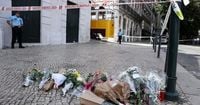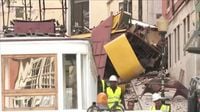Lisbon, Portugal — A tragic accident struck the heart of Lisbon on September 3, 2025, when a historic funicular railway, beloved by locals and tourists alike, careened out of control and crashed into a building at the bottom of a steep hill. The disaster left at least 16 people dead and 22 injured, marking one of the city’s deadliest incidents in recent memory and casting a shadow over the Portuguese capital’s vibrant streets.
The accident occurred on the Elevador da Glória, a yellow-and-white tram-like funicular that has been a fixture in central Lisbon since 1885. According to BBC and Portuguese officials, the funicular is not only a vital piece of public transportation but also a cherished landmark, whisking passengers up and down a daunting incline between the bustling downtown and the Bairro Alto district. On that Wednesday afternoon, however, the routine journey turned catastrophic.
The initial moments of the crash were as sudden as they were horrifying. The Portuguese Office for Air and Rail Accident Investigations released a preliminary report on September 6, 2025, detailing the chain of events. The funicular’s two cabins had traveled “not more than about six meters” when they “suddenly lost the balancing force provided by the cable connecting them.” The system, which relies on the tension of a cable to keep both cabins in check as they move in opposite directions, failed without warning.
As the report described, “Cabin No. 2 suddenly reversed, its movement halting approximately 10 meters beyond due to its partial excursion past the end of the track and the burial of the underside of the trambolho (trolley) at the end of the cable trench.” Meanwhile, “Cabin No. 1, at the top of Calcada da Gloria, continued its downward movement, increasing its speed.” The brakeman on board reacted instantly, applying both the pneumatic and hand brakes in a desperate attempt to stop the accelerating carriage. Tragically, “these actions had no effect in stopping or reducing the cabin’s speed, and it continued accelerating down the slope.”
The runaway carriage ultimately left the rails and slammed into a building at the bottom of the hill, just meters from where its twin would have stopped. The aftermath was grim: twisted metal, shattered glass, and a carriage lying on its side, partially crumpled against the narrow, curved street. Emergency workers rushed to the scene, but after about two hours, most stood down as the scope of the tragedy became clear.
Victims of the crash represented a cross-section of Lisbon’s international visitors and residents. Canadian André Bergeron and his wife, Blandine Daux—a dual Canadian-French citizen—were among those who lost their lives, as reported by Global News. Other victims included five Portuguese nationals, three British citizens, two South Koreans, one American, one French, one Swiss, and one Ukrainian, according to Portuguese officials. The U.S. State Department confirmed that an American citizen was among the deceased. The National Institute for Medical Emergencies noted that five of the injured were in serious condition, and a child was among those hurt.
Eyewitnesses recounted scenes of chaos and disbelief as the funicular, which had just begun its descent, suddenly picked up speed and barreled out of control. Local media captured the shock of bystanders, some of whom described the carriage as “careening down the hill, apparently out of control.” The incident happened so quickly that few had time to react, and the steepness of the hill left little room for error.
Authorities moved swiftly to respond. Lisbon Mayor Carlos Moedas declared three days of municipal mourning, expressing the city’s collective grief in a statement on social media: “The Lisbon City Council decrees three days of Municipal Mourning for the victims of the tragic accident at the Glória Funicular. I extend my heartfelt condolences to all the families and friends of the victims. Lisbon is in mourning.” Portuguese President Marcelo Rebelo de Sousa echoed these sentiments, saying he “deeply regrets the accident” and offered “his condolences and solidarity with the families affected by this tragedy.”
As investigators combed through the wreckage, the focus quickly turned to the cause of the disaster. According to a report released by Portugal’s authority in charge of railway and air traffic incidents, “from the on-site study of the wreckage, it was immediately clear that the cable connecting the two cabins had given way at its attachment point.” This cable, which had been installed less than a year earlier, was not scheduled for replacement for another 263 days, raising urgent questions about maintenance protocols and equipment reliability.
Carris, the company that operates the funicular, stated that scheduled maintenance had been carried out prior to the incident. However, the preliminary findings suggest that even recent maintenance could not prevent the critical failure of the cable. The investigation’s early results point to the cable snapping as the immediate cause, but the underlying reasons—whether material fatigue, installation error, or another factor—remain under scrutiny. A final report is expected in the coming months.
This accident, deemed the worst of its kind in Lisbon’s recent history, has prompted soul-searching among city officials and the broader public. The Elevador da Glória is more than just a means of transportation; it is woven into the city’s identity, drawing thousands of tourists each year who marvel at its historic design and the panoramic views it offers. Its closure, however temporary, is a blow to Lisbon’s spirit and a stark reminder of the risks inherent in aging infrastructure.
For the families of those lost, the grief is immeasurable. International consulates have been working to provide support, and tributes have poured in from around the world. The diversity of the victims highlights Lisbon’s role as a global city, open to visitors from every corner of the map. The tragedy has united the city in mourning, but it has also sparked calls for greater oversight and investment in public transportation safety.
As Lisbon looks ahead, the focus will be on learning from this calamity. The forthcoming final report from the Office for Air and Rail Accident Investigations will be crucial in determining accountability and preventing future tragedies. For now, the city pauses, remembers, and waits for answers—hoping that the lessons learned will ensure such a disaster never happens again.



